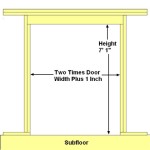Cost of Installing a Patio Door: A Comprehensive Guide
Patio doors offer a seamless transition between indoor and outdoor living spaces, enhancing aesthetics, increasing natural light, and potentially adding value to a property. However, installing a patio door involves various factors that influence the overall cost. This article provides a detailed overview of the key elements affecting the cost of patio door installation, helping homeowners make informed decisions.
Understanding the Factors Influencing Patio Door Installation Costs
Several variables contribute to the final cost of installing a patio door. These range from the type of door chosen to the complexity of the installation process. A thorough understanding of these factors is crucial for accurate budgeting and avoiding unexpected expenses.
Firstly, the type of patio door selected significantly impacts the price. Sliding glass doors are generally more affordable than French doors or bi-fold doors. Sliding doors offer a simple, space-saving design, while French doors provide a more traditional and elegant look. Bi-fold doors, which fold open completely, offer the widest opening and are the most expensive option. The materials used in the door's construction also play a role. Vinyl doors tend to be the most budget-friendly, followed by wood, fiberglass, and aluminum.
Secondly, the size and dimensions of the patio door opening influence the cost. Larger doors naturally require more materials and labor, resulting in a higher price. Custom-sized doors, necessary when the existing opening doesn’t conform to standard sizes, can further increase the cost. Modifying the opening to accommodate a standard-sized door might be a more cost-effective solution in some cases, but this also adds to the overall project expenses.
Thirdly, the complexity of the installation is a major cost driver. Replacing an existing patio door with a similar model in the same size opening is typically a straightforward process with lower labor costs. However, if the installation involves structural modifications, such as enlarging the opening, reinforcing the header, or dealing with hidden problems like rot or water damage, the cost can escalate substantially. Removing and disposing of the old door also adds to the expense.
Fourthly, labor costs vary depending on the location and the experience of the installer. Hiring a licensed and insured contractor generally costs more than hiring a handyman, but it also provides greater assurance of quality workmanship and adherence to building codes. Obtaining multiple quotes from different contractors is essential to compare prices and services offered. Local building permits may be required for patio door installations, adding another layer of cost to the project.
Fifthly, additional features and upgrades can significantly affect the overall cost. These may include energy-efficient glass (such as Low-E coatings or argon gas fills), upgraded hardware (like multi-point locking systems or decorative handles), and built-in blinds or screens. While these features enhance the door's functionality and aesthetics, they also contribute to a higher price tag. Furthermore, the finishing touches, such as interior and exterior trim, painting, or staining, will add to the project cost.
Breaking Down the Costs: Materials, Labor, and Permitting
To gain a clearer understanding of the expense involved, it’s helpful to analyze the separate components that contribute to the total cost of installing a patio door. These typically include the cost of materials (the door itself and any necessary supplies), labor costs for the installation, and any fees associated with permits or inspections.
The cost of the patio door itself can range widely, from a few hundred dollars for a basic vinyl sliding door to several thousand dollars for high-end French or bi-fold doors made from premium materials like wood or fiberglass. Energy-efficient features, custom sizes, and upgraded hardware will all increase the price of the door. It's important to research different brands, models, and materials to find the best combination of quality and affordability that meets individual needs and budget.
Labor costs are usually a significant portion of the overall expense, typically ranging from $300 to $1,000 or more, depending on the complexity of the installation. Simple replacements might fall on the lower end of this range, while installations requiring structural modifications or custom work will likely cost more. The hourly rate for professional installers can vary depending on the location and the contractor's experience. Obtaining detailed estimates from multiple contractors is crucial to compare labor costs and ensure transparency in pricing.
Permitting fees vary by municipality and are typically required for any construction project that involves altering the structure of a building. These fees can range from a few dollars to several hundred dollars, depending on the scope of the work and the local regulations. Obtaining the necessary permits is essential to ensure compliance with building codes and avoid potential fines or legal issues. The permit process may also involve inspections by local building officials to verify that the installation meets safety and structural standards.
Furthermore, homeowners should consider the cost of disposing of the old patio door. Some contractors include the cost of disposal in their estimate, while others may charge an additional fee. Disposing of a large, bulky item like a patio door can be challenging and may require specialized services. Recycling the old door, if possible, is an environmentally friendly option that may also reduce disposal costs.
Strategies for Managing and Reducing Patio Door Installation Costs
While installing a patio door can be a significant investment, there are several strategies homeowners can employ to manage and potentially reduce the overall costs. Careful planning, strategic decision-making, and a bit of research can help optimize the budget without compromising on quality or functionality.
Firstly, obtaining multiple quotes from different contractors is one of the most effective ways to ensure a fair price. Comparing bids from several qualified installers allows homeowners to assess the market rate for the project and identify any discrepancies or hidden costs. It's important to request detailed estimates that specify the cost of materials, labor, and any other associated fees. Carefully review each estimate to ensure that all aspects of the project are covered and that there are no unexpected surprises.
Secondly, choosing a standard-sized door can significantly reduce costs. Custom-sized doors are more expensive due to the increased material and manufacturing costs. Modifying the existing opening to accommodate a standard-sized door might be a more cost-effective solution, provided that the modifications are relatively minor and don't require extensive structural work. Consult with a contractor to assess the feasibility and cost of modifying the opening before ordering a custom-sized door.
Thirdly, opting for a less expensive material, such as vinyl, can help lower the overall cost. Vinyl doors are generally more affordable than wood, fiberglass, or aluminum doors, while still offering good durability and energy efficiency. Consider the long-term maintenance costs associated with different materials when making a decision. While wood doors may be aesthetically appealing, they require regular painting or staining to prevent rot and decay. Vinyl doors are virtually maintenance-free and resist moisture and insects.
Fourthly, carefully consider additional features and upgrades. While energy-efficient glass and upgraded hardware can enhance the door's performance and aesthetics, they also add to the cost. Prioritize the features that are most important and beneficial for the specific climate and lifestyle. For example, in colder climates, energy-efficient glass is a worthwhile investment to reduce heating costs. In areas with high crime rates, a multi-point locking system can provide added security.
Fifthly, consider DIY options for certain aspects of the project. While the actual installation of the patio door should be left to a professional, homeowners can often handle tasks such as removing old trim, painting or staining the new trim, or cleaning up the work area. Performing these tasks themselves can save on labor costs. However, it's important to be realistic about skill level and time commitment before taking on any DIY projects. Improperly installed trim or poorly applied paint can detract from the overall appearance and potentially lead to future problems.
Finally, carefully consider the timing of the installation. Contractors may be less busy during certain times of the year, potentially leading to lower labor costs. It might be possible to negotiate a better price if the installation is scheduled during a less busy period. However, avoid scheduling the installation during extreme weather conditions, as this can delay the project and potentially increase costs due to weather-related complications.
By understanding the various factors that influence the cost of installing a patio door and implementing these cost-saving strategies, homeowners can make informed decisions and effectively manage their budgets for this important home improvement project.

How Much Does Patio Door Replacement Cost In 2024 Checkatrade

How Much Does It Cost To Install Sliding Glass Doors Homeserve Usa

2024 Patio Door Replacement Cost Angi

Fixr Com Sliding Patio Door Cost To Install

2024 Cost To Install French Doors Angi

How Much Does Sliding Patio Door Installation Cost 2024 Today S Homeowner

French Doors Cost Guide 2024 How Much Are

Cost To Install Doors The Home Depot

How Much Do Sliding Glass Patio Doors Cost 2024

Cost To Install Patio Doors How Much Do In 2024








